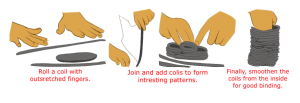Key Pointers
- There is both plain and painted pottery, with plain being the most prevalent
- Plain pottery is usually constructed of red clay and has a fine red or grey slip applied to it
- Black painted pottery with a thin red slip covering and painted geometric and animal motifs
- There was also perforated earthenware, maybe for use as a sieve
- Excavation yielded a variety of sized pottery.
The art of pottery in all probability is as old as human history. Pottery is the one and only art form that leaves clear traces of the human on this earth. It can be legitimised by the following facts:
- Clay is found in abundance in all parts of the world
- Clay items are the least perishable of all materials.
Clay
Clay is essentially silica but the varying mineral content in clay adds to its colour and determines its suitability for different processes.
- Along the side of riverbeds and banks, lakes and ponds, and agricultural lands, sources of different types of clay are found in India
- When clay is mixed with water it becomes malleable and elastic. By controlling the amount of water, it can be used in different ways.
- A velvety substance can be prepared that is poured into moulds and allowed to set
- It is then converted into a leathery consistency and a sponge-like cut is made
- Dry surface can be scraped off as fine powder
- Straw and grass can be added to create a strong, rough texture which is ideal for the creation of very large images.
Pottery
- The object becomes rigid by going through a chemical change immediately after the object is fired or dried
- Artists use dirt to create objects for the home – cooking pots, rooftop tiles, earth blocks and models
Two common techniques are performed to prepare clay items:
- Wheel-turned pottery
- Hand modelling
Wheel-turned Pottery
There are many forms of wheels used in India
- Flat stone or wooden disc: The flat stone or wooden disc is turned with the hand or a stick
- Change shape of clay: It is done by placing a soft lump of clay on the centre of the disc and turning the wheel
- Different sizes and shapes: Pot of different sizes and shapes are created by varying the pressure of the fingers and palms she/he can create
- Hollow Shape: It is achieved by pushing thumbs down into the centre of the ball of clay and pulling gently outward and upward
- Double Disc: A wheel is mounted on a vertical shaft. The wheel can be turned with the feet by extending the shaft and placing another disc at the bottom. It makes both hands free to shape the pot
- Motorized wheels: These have started to become popular nowadays.
Hand Modelling
Modelling is done with materials like clay, wax, or plaster. Artists can work from the core to the outside using clay modelling. To make it realistic, clay can be rolled, coiled, pinched, and attached to the main form.
- This technique is used to create a sculpture
- The artist can alter, replace and repair the parts of the model whenever he wills
- If the nose of the figure slumps, the artist can just moisten the clay piece and fix it back on to the face
- Artists can later add smaller details of hair, bangles, and necklaces in clay
- Decoration: Different textures and designs can be carved on the wet surface of pots, which can be pressed or imprinted, cut out or put on like appliqué and then many sections of the clay object can be assembled to forge a cohesive hole.

Hand modelling
Painting: Slip, a thin aqueous solution of clay is poured by the craftsman after firing the object, which imparts an even colour to the clay. Minerals colours are used to add extra values to the appearance of the object
Terracotta
Once the clay object is made, it can be dried in the sun and fired in a local kiln made of cow-dung and wood. This process transforms the clay into terracotta, making it insoluble, un-plastic and durable.
- Clay can be fired at different temperatures from 700 to 1400 degrees Celsius
- The terracotta gets its colour from the intensity of heat and the type of firing performed and hue that range from dark brown to lively reds.
This has made the 5000-year-old seals from the Harappan Civilization to still exist.
Conclusion
Early villages at Mehargarh from the Indus Valley Civilization have been discovered with ceramic evidence. It is still widely done in India today as a form of cultural expression. In the study of culture and the reconstruction of the past, pottery plays a crucial role. The style of pottery varied over time as different cultures developed. It represents the social, economic, and environmental conditions in which a civilization flourished, allowing archaeologists and historians to better comprehend our history. It’s useful for deciphering cultures where there’s no writing or where it’s difficult to read.
 Profile
Profile Settings
Settings Refer your friends
Refer your friends Sign out
Sign out













